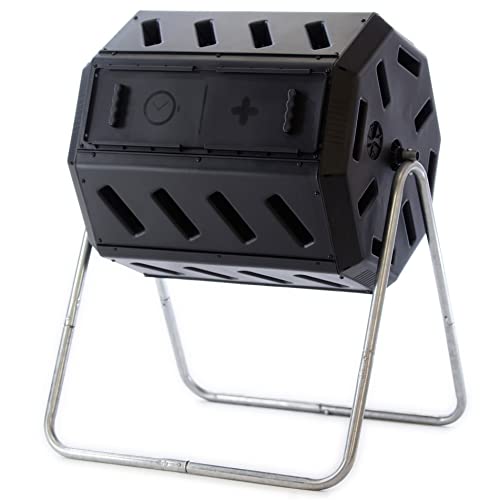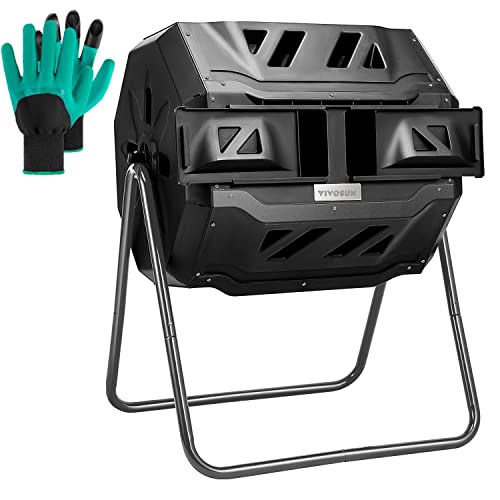Making your compost is both economical and environmentally friendly. Instead of purchasing expensive bags of virtually free soil and plant feed, consider making your own compost heap in which you are free to decide what goes in or stays out of your compost.

This website is supported by readers. As an Amazon Associate we earn from qualifying purchases.
One of the most effective tools to help ease the composting process is a compost bin. Compost, if done without the help of a composter, can take up to a year to fully mature. With a composter, you can cut the decomposition time to only a matter of months.
However, making your own compost with a composter tumbler or static model isn’t as simple as dumping everything in the bin and wishing it’ll decompose flawlessly. It takes a little bit of work and knowledge to make usable compost that benefits your garden’s soil and plants.

What to put in a compost bin
There are two important components that go into a compost bin: the organic matter and the microorganisms.
Organic Matter
The organic matter is further divided into two categories: nitrogen- and carbon-releasing materials. Nitrogen also referred to as “greens” in the composting world, gives microbes much-needed protein to build up their cell walls. The higher-quality greens you put into the compost bin, the higher the chance that the microorganisms will survive.
Nitrogen-rich materials are oftentimes referred to as “activators” since they help in producing heat which accelerates the decomposition process. Great sources of nitrogen include all sorts of plant debris, coffee grounds, and even animal by-products like blood and manure.

The second organic matter category is carbon-releasing materials, known simply as “browns.” Browns are the microorganism’s fuel source. The microbes munch on browns to keep them working, ensuring that the decomposition process continues.
Carbon-rich materials such as biodegradable paper, wood chips, dry leaves, and even peanut shells can all go to feed your microscopic friends. The ideal ratio between greens and browns is between 1:25 and 1:30.
Microorganisms
We’ve talked a little bit about the microorganisms thriving in your compost bin, but where do they come fromBasically, they’ll sprout seemingly out of nowhere. As you put in vegetable scraps and fallen leaves, microorganisms latching to these materials will enter into the compost bin and begin their life-long party of continuous feasting and reproduce.
However, you can help up the population of microorganisms in your compost bin by purchasing them from nurseries or garden supply stores. Usually, the microorganisms they supply are specific for decomposition, so it might be a good idea to shell out a couple of bucks to purchase an additional army of microbes.

Moisture
If you’ve ever left garbage to build up in your home, then you’ll know how stinky it can be. The funk is usually caused by moisture which helps accelerate the decomposition process. Like garbage, your compost should be adequately moistened to ensure that the microbes survive and continue their feast.
Adequate levels of moisture mean moist like a wrung-out sponge, not sopping wet. Microorganisms can drown, too. Give the contents of your compost bin a few spritzes of water from a spray bottle every week or so.

Heat
Although heat isn’t something you can actually put into the compost bin, it’s something that you definitely need to consider. In fact, the microorganisms will produce their own heat which accelerates the decomposition process significantly.
If you can retain the heat inside of the bin, then your compost should be ready in only a matter of months. This, however, doesn’t mean you should expose your compost bin to direct sunlight since excessive heat can kill your microorganisms and dry out your compost.

Conclusion
And that, ladies and gentlemen, is how it’s done. Making your own compost with the help of a reliable compost bin is simple to do. Sure, it requires a bit of monitoring and maintenance, but it’s definitely worth doing, especially if you can save a few (hundred) bucks on compost annually.
Be sure that you have a good compost bin to work with, have the right materials – both green and brown – on hand, maintain the ideal 1:25 to 1:30 ratio between the organic materials, and give your pile a spritz of water every so often and your compost will be ready to use before the end of the year! That may sound long and tedious, but it’s much quicker than making your own compost in a bucket or compost pile which could take up to a year (if you’re lucky).

Composter Tumbler | Recommended
Last update on 2024-03-26 / Affiliate links / Images from Amazon Product Advertising API
This website is supported by readers. As an Amazon Associate we earn from qualifying purchases.
If you have any questions or do you spot any mistakes, please add them below.


